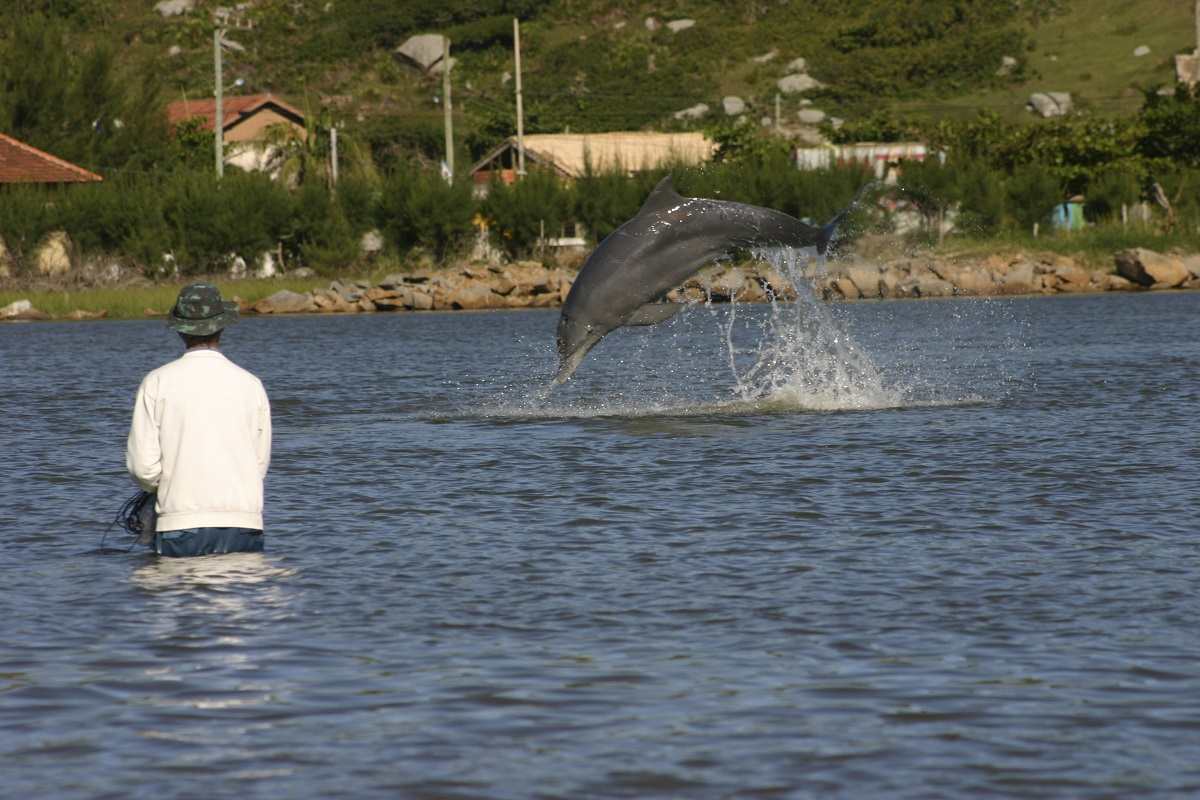
In this 2008 photo, provided by Oregon State University, dolphin jump in front of fishermen at Praia da Tesoura, in Laguna, Brazil.
12:27 JST, January 31, 2023
A fishing community in southern Brazil has an unusual ally: wild dolphins.
Accounts of people and dolphins working together to hunt fish go back millennia, from the time of the Roman Empire near what is now southern France to 19th century Queensland, Australia. But while historians and storytellers have recounted the human point of view, it’s been impossible to confirm how the dolphins have benefited — or if they’ve been taken advantage of — before sonar and underwater microphones could track them underwater.
In the seaside city of Laguna, scientists have, for the first time, used drones, underwater sound recordings and other tools to document how local people and dolphins coordinate actions and benefit from each other’s labor. The most successful humans and dolphins are skilled at reading each other’s body language. The research was published Monday in the journal Proceedings of the National Academy of Sciences.
The Laguna residents work with wild bottlenose dolphins to catch schools of migratory silver fish called mullet. It’s a locally famous alliance that has been recorded in newspaper records going back 150 years.
“This study clearly shows that both dolphins and humans are paying attention to each other’s behavior, and that dolphins provide a cue to when the nets should be cast,” said Stephanie King, a biologist who studies dolphin communication at the University of Bristol and was not involved in the research.
“This is really incredible cooperative behavior,” she added. “By working with the dolphins,” the people catch more fish, “and the dolphins are more successful in foraging, too.”
Dolphins and humans are both highly intelligent and long-lived social animals. But when it comes to fishing, they have different abilities.
“The water is really murky here, so the people can’t see the schools of fish. But the dolphins use sounds to find them, by emitting small clicks,” much as bats use echolocation, said Mauricio Cantor, an Oregon State University marine biologist and study co-author.
As the dolphins herd the fish toward the coast, the people run into the water holding hand nets.
“They wait for dolphins to signal exactly where fish are – the most common signal is what locals call ‘a jump,’ or a sudden deep dive,” said Cantor, who is also affiliated with the Federal University of Santa Catarina in Florianópolis, Brazil.
The researchers used sonar and underwater microphones to track the positions of the dolphins and fish, while drones recorded the interactions from above, and GPS devices attached to residents’ wrists recorded when they cast their nets.
The more closely the people synchronized their net-casting to the dolphins’ signals, the more likely they were to trap a large catch.
So what’s in it for the dolphins?
The descending nets startle the fish, which break into smaller schools that are easier for dolphins to hunt. “The dolphins may also take one or two fish from the net – sometimes fishers can feel dolphin tugging a little on the net,” said Cantor.
The Laguna residents categorize the individual dolphins as “good,” “bad,” or “lazy” — based on their skill in hunting and affinity for cooperating with humans, said Cantor. The people get most excited when they see a “good” dolphin approaching shore.
“These dolphins and humans have developed a joint foraging culture that allows them both to do better,” said Boris Worm, a marine ecologist at Dalhousie University in Halifax, Canada, who was not involved in the research.
It’s not clear how the Laguna cooperation first emerged, but it’s survived multiple human and dolphin generations – with knowledge passed down by experienced fishers and dolphins to the next generation of each species.
Still, the researchers in Brazil worry that the Laguna alliance, perhaps one of the last of its kind, may be in danger as well, as pollution threatens the dolphins and artisanal fishing gives way to industrial methods.
“Human-wildlife cooperation is disappearing because we’re decimating the wildlife populations,” said Janet Mann, a dolphin researcher at Georgetown University, who was not involved in the study.
Scientists hope that greater awareness of the unusual interspecies cooperation can help drive support to protect it. “It’s amazing that it’s lasted for over a century – can we keep this cultural tradition alive amid many changes?” said Damien Farine, a University of Zurich biologist and study co-author.
"News Services" POPULAR ARTICLE
-

American Playwright Jeremy O. Harris Arrested in Japan on Alleged Drug Smuggling
-

Japan’s Nikkei Stock Average as JGB Yields, Yen Rise on Rate-Hike Bets
-

Japan’s Nikkei Stock Average Licks Wounds after Selloff Sparked by BOJ Hike Bets (UPDATE 1)
-

Japanese Bond Yields Zoom, Stocks Slide as Rate Hike Looms
-

Japan’s Nikkei Stock Average Buoyed by Stable Yen; SoftBank’s Slide Caps Gains (UPDATE 1)
JN ACCESS RANKING
-

Keidanren Chairman Yoshinobu Tsutsui Visits Kashiwazaki-Kariwa Nuclear Power Plant; Inspects New Emergency Safety System
-

Imports of Rare Earths from China Facing Delays, May Be Caused by Deterioration of Japan-China Relations
-

University of Tokyo Professor Discusses Japanese Economic Security in Interview Ahead of Forum
-

Japan Pulls out of Vietnam Nuclear Project, Complicating Hanoi’s Power Plans
-

Govt Aims to Expand NISA Program Lineup, Abolish Age Restriction

























